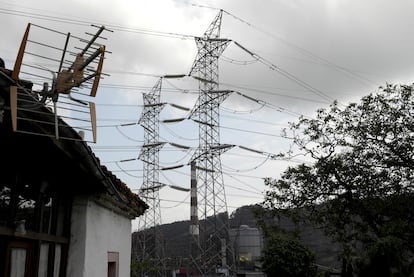Heatwave in Spain expected to push up cost of electricity to new highs
Experts predict the lack of wind power and greater demand due to air conditioning will lead to record-breaking prices


Outdoors, there is no wind to alleviate the suffocating heat; inside, millions of air conditioners are humming. It is the worst possible scenario for the electricity market in Spain. Add in other factors, such as high gas prices and the cost of releasing carbon dioxide (CO2) under the European Union’s emissions trading scheme and you get an explosive cocktail that can only end in more expensive electricity.
For the past three days, Spain has seen record-high electricity prices. Now, as the country enters its first heatwave of the summer, the cost is expected to continue to rise. On the bright side, Spain’s national weather agency Aemet indicates that the high temperatures will peak at the weekend when the cost of electricity is at its cheapest in the government’s new three-tiered price system introduced at the start of June to encourage more efficient electricity consumption and to let consumers play an active role in the country’s decarbonization efforts.
But until the weekend, Spain is likely to see headline-grabbing electricity prices. Wednesday is already proving to be the most expensive day ever for electricity on the wholesale market, with an average price of €113.99 per megawatt-hour (MWh). “On Thursday there may be another record and on Friday let’s see, because demand tends to drop off a little [towards the weekend],” says energy analyst Ricardo Margalejo, co-founder of the trading company Gana Energía. “We have four days of pretty intense heat coming up which will mean demand being a little higher, but there will also be no wind, so we will need to burn more gas to generate electricity.”
Electricity prices on the wholesale market in Spain, up to a third of which are passed onto the consumer, especially those using the PVPC regulated tariff, depend on a daily auction. Companies producing energy offer prices by the hour. These are matched with predicted demand and the highest price is the one that determines what is paid in each hourly slot. The price over the course of the day is an average. The fact that it is not necessary to produce electricity from the more expensive fossil fuels at a certain time of day when demand is lower can drive the average down significantly.
The fallout from a freezing winter
But that is not currently the case. August, explains Margalejo, is the month in which there is traditionally less wind energy produced in Spain and it is not a good time for other renewables either. This means that within the combination of sources that generate electricity – the so-called pool – those that use gas, such as combined cycle power plants, gain ground. When these companies put in their offers on the wholesale market, the figures are necessarily high because international gas prices are on the rise. In fact, they have climbed to €44 per megawatt this year from around €15. According to Margalejo, future forecasts indicate they will reach €46 per megawatt. The reason for this is that last winter was colder than usual and in many countries, particularly in China, there was a greater drain on reserves than usual. Now they have to replenish these reserves, which in turn drives up prices.
Then there is the cost of releasing CO2, as set by the EU emissions trading system, that must be paid by companies that are polluting the atmosphere. As the EU cracks down on fossil fuels, the cost of polluting has also risen. A report published on Tuesday by the Bank of Spain pointed out that CO2 emission allowances are responsible for 20% of the surge in electricity prices, making it the second most important factor after the increased price of gas, which is responsible for 50% of the rise. Combined, they are responsible for 70% of the current price hike.
These two factors will not be changing any time soon and analysts predict high electricity prices until next February at least. But that does not mean record-breaking prices, which is what Spain is experiencing now. The Iberian Energy Market Operator (Omie), which manages Spain and Portugal’s markets – forecasts that prices for this Thursday will stand at €110 per MWh. This is the same as predicted for Wednesday, when the average finally reached €114. For Friday, the predicted average drops slightly to €105 as industrial demand begins to fall on the last day of the working week. At the weekend, lower prices are expected: just over €90 per MWh on Saturday and just under €80 on Sunday. Last August, no day exceeded €53.
According to forecasts, the prices for Thursday will stand at €110 per MWh. Last August, no day exceeded €53
Lowering prices will not be easy. The government has already temporarily modified two taxes; reducing the sales tax (VAT) on the electricity bill from 21% to 10% and eliminating the tax on electricity generation. There is some margin left on the electricity tax (5.11%) and other costs and tariffs on the bill, but none of this changes what is happening at the source. There could be a European decision on the emissions trading system, but this seems unlikely, as does a reform of the wholesale market, which is basically the same for all EU member states.
Autumn should bring with it more wind power. But then the markets will once again be holding their breath: “Depending on the state of the gas market, winter could be very difficult in some places and the current €100 may not cover it,” says Margalejo. Any extreme, whether hot or cold, drives up the bill.
English version by Heather Galloway.
Tu suscripción se está usando en otro dispositivo
¿Quieres añadir otro usuario a tu suscripción?
Si continúas leyendo en este dispositivo, no se podrá leer en el otro.
FlechaTu suscripción se está usando en otro dispositivo y solo puedes acceder a EL PAÍS desde un dispositivo a la vez.
Si quieres compartir tu cuenta, cambia tu suscripción a la modalidad Premium, así podrás añadir otro usuario. Cada uno accederá con su propia cuenta de email, lo que os permitirá personalizar vuestra experiencia en EL PAÍS.
¿Tienes una suscripción de empresa? Accede aquí para contratar más cuentas.
En el caso de no saber quién está usando tu cuenta, te recomendamos cambiar tu contraseña aquí.
Si decides continuar compartiendo tu cuenta, este mensaje se mostrará en tu dispositivo y en el de la otra persona que está usando tu cuenta de forma indefinida, afectando a tu experiencia de lectura. Puedes consultar aquí los términos y condiciones de la suscripción digital.
More information
Últimas noticias
The story of the Málaga virus: The code that haunted Google’s cybersecurity center director for 30 years
The impact of Ecuador’s mega-prison: A polluted river, cleared forests and military checkpoints
Corinne Low: ‘I’m more concerned about the female happiness gap than the gender wage gap’
Trump traveled on Epstein’s plane ‘many more times’ than previously thought, according to new documents
Most viewed
- The low-cost creative revolution: How technology is making art accessible to everyone
- Christian Louboutin: ‘Young people don’t want to be like their parents. And if their parents wear sneakers, they’re going to look for something else’
- All the effects of gentrification in one corner of Mexico’s Colonia Roma
- Liset Menéndez de la Prida, neuroscientist: ‘It’s not normal to constantly seek pleasure; it’s important to be bored, to be calm’
- Christmas loses its festive spirit: ICE fears cast shadow over religious celebrations









































